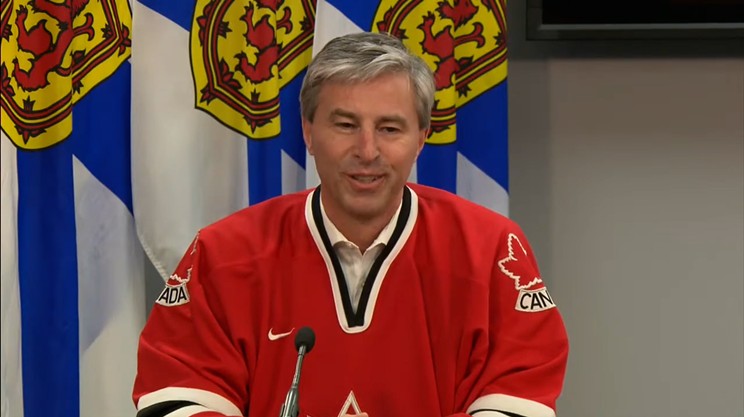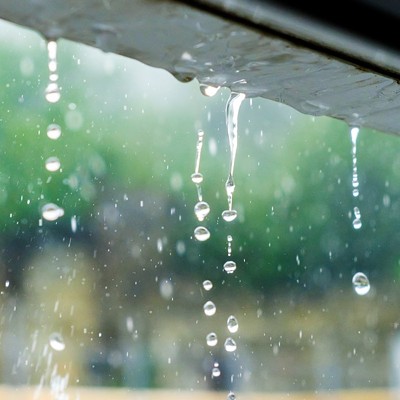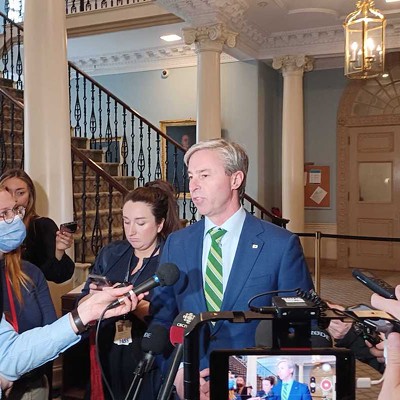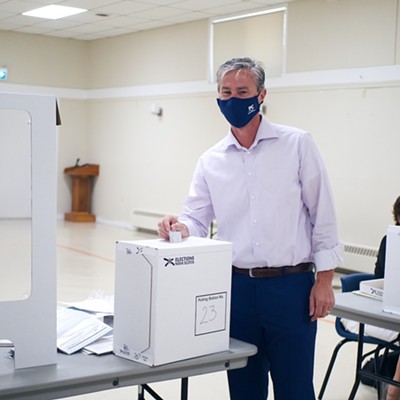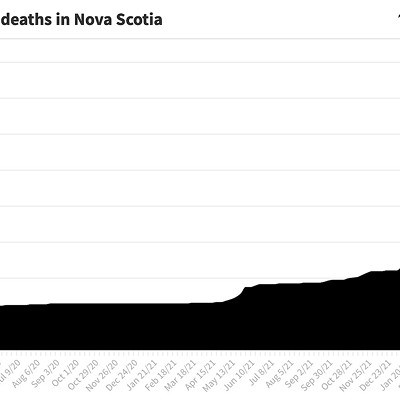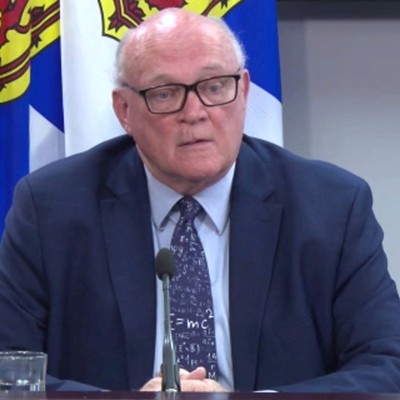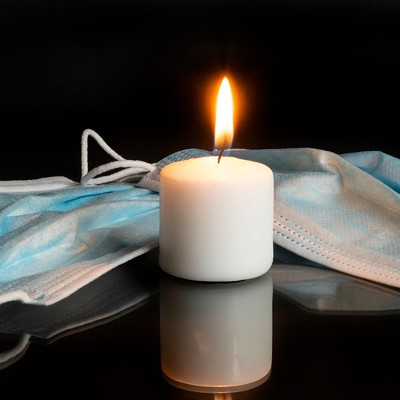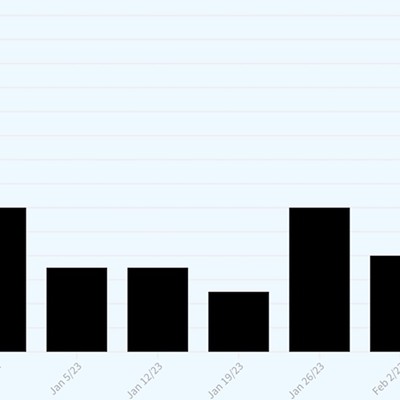Monday morning at 8:30, the province sent an email to media organizations advising that Dr. Robert Strang would be holding a virtual press conference at 1pm "to answer questions about COVID-19." My first thought was that Nova Scotia's chief medical officer of health wanted to talk about the BA4 and BA5 virus variants that are becoming a looming threat.
That very day in the New York Times, a story talked about the surge of cases driven by these "most evasive forms of Omicron yet," with an attendant rise in fatalities: "In the worst case, epidemiologists have predicted some 200,000 Covid deaths in the United States within the next year." I guessed that Strang might be getting out in front of the coming wave, preparing the public for new restrictions to dampen its impact. I literally couldn't have been more wrong.
About an hour before the press conference started, the province sent out another email, a news release announcing that "Nova Scotia will remove all remaining COVID-19 restrictions in the community on Wednesday, July 6." There weren't many restrictions left to remove, after most rules on masking, distancing and gathering were lifted back in March. With this latest change, the province is really targeting some fundamental ideas about COVID, particularly the notion that infected people need to isolate from uninfected people to limit disease spread. Starting Wednesday at one minute after midnight, "isolation shifts from being mandatory to strongly recommended for people who test positive for COVID-19."
We have passed that starting point. Right now in Halifax—and every other place in Nova Scotia—nobody ever has to wear a mask, outside of some high-risk settings like hospitals. Even a person with COVID, a person with active symptoms who decides not to accept the recommendation to isolate and instead gets on a Halifax Transit bus and goes to work, is only "strongly recommended" to mask up. The province says "it is each person's own decision whether to wear a mask, weighing their risk factors and comfort and those of people around them."
In line with the new way of thinking—or not thinking—about the pandemic, the province also made it harder to test for the disease. People in a "low-risk category" can only get rapid tests and will not be PCR tested, even after a positive rapid test, which I suppose is one way to keep infection statistics low in provincial reports. Speaking of, Nova Scotia is switching from weekly to monthly reporting. COVID data from June will be announced July 15, making some of that data six weeks old before people can even consider using it for "weighing their risk factors and comfort."
Public response to Monday's announcement is running the predictable spectrum from applauding to questioning to anger. Strang's press conference only dealt with questions, so I'll touch on the main ones below along with a sampling from Twitter.
WTF Dr. Strang?
Strang started the press conference with very brief remarks to explain why Nova Scotia is dropping all COVID restrictions, including the reason that everyone else is doing it. "We're at a place now with our epidemiology and our ongoing adaptation to COVID being with us for the long term, that we feel we're at a point now where it's appropriate to do what many other provinces have already done, and make some adjustments to our last remaining restrictions in the areas of isolation, masking and testing."
All Covid restrictions have been lifted in Nova Scotia. Our government gives NO fucks about you and Covid - they just want the big tourist money machine to continue pouring cash into their coffers. A big fuck you to the vulnerable and those with a compromised immune system.
— Rollin' Red - Homegrown Nova Scotian (@RollingRedRoads) July 6, 2022
The Chronicle-Herald's John McPhee, pointing out the obvious concern that the disease will spread more in the absence of any rules designed to stop it, pushed Strang for more of an explanation. "We have to have an approach to COVID that's sustainable and feasible over the long term," Strang began, sounding like a politician, but then he reverted back to doctor. "The levels of COVID activity right now are low enough, and the vast majority of people are protected against severe illness by vaccination, that we feel it's appropriate" to eliminate restrictions.
What even is a strong recommendation?
In the early years of COVID, back in 2020 and 2021, then-premier Stephen McNeil was publicly in lockstep with Strang; they appeared together constantly, and McNeil obviously took Strang's advice when charting the province's COVID direction. Public health and politics have strayed from each other since Tim Houston's election. The current premier is clearly over COVID—Houston hasn't appeared at a pandemic press conference for months, and his name didn't come up once on Monday—giving rise to situations where provincial rules and health recommendations say different things.
Strang: “Govern yourself accordingly”
— Andy Bowers (@evilpez4) July 6, 2022
Peggys Cove Black Rocks: “LOL”
Strang took the opportunity Monday to stress that he still has serious recommendations despite the new rule-free normal. When a person with COVID has to "do a critical errand or go for a health care visit," as he put it to McPhee, "it's vitally important that you are wearing a mask, an appropriate mask and wearing it properly when you're when you're making those kinds of visits."
To AllNovaScotia's Brian Flinn, Strang said "it's perfectly acceptable if people choose to wear masks," repeating "it's vitally important" for people with cold and flu symptoms to be masked in public. "We're also strongly recommending that people in crowded indoor places, where there's lots of people around in a small space, that that's a specific situation where we're still strongly recommending that people continue to wear masks."
Will COVID spread more without isolation rules?
Strang took an interesting tack after Alicia Draus of Global News asked if COVID spread will increase when there is no rule that people with the disease have to isolate. He said that even with the rule in place, it was so difficult to enforce that the province didn't bother much, and people have actually been regulating themselves for a while.
Starting Wednesday in Nova Scotia, someone sick with COVID can walk into a restaurant without a mask, scan the crowd for a senior, or someone who’s pregnant, and decide to sit right next to them and have a nice little chat.
— Mark Laventure (@marklaventure) July 4, 2022
It’s totally legal.#nspoli
"So all along it has really been asking Nova Scotians to do the right thing," said Strang. "We're just shifting now to basically saying if at all possible…if you're sick with colds and flu symptoms, you need to stay home away from others."
Strang went further down the road of saying the rules never mattered when Lyndsay Armstrong from the Canadian Press pushed about the wisdom of ending the isolation requirement. "I don't believe that that really was keeping many people home," he said. "People who were able to, and knew the right thing to do, will continue to do that." In Strang's telling, dropping the pretense of rules is a "shift from legally-mandated-but-not-enforced, to really just a much more practical approach, which is what we've done for years with influenza and everything—always recommending to people if at all possible, stay at home when you're acutely ill."
How can we stay informed when the province cuts information?
Strang's zeal for self-reliance was also on display when Halifax Examiner founder Tim Bousquet asked how people are supposed to gauge their day-to-day safety when the province reports disease data monthly. "The decisions about how you keep yourself safe, and others safe, aren't necessarily based so much on the epidemiology," Strang said, "especially when the epidemiology is not changing rapidly."
How government treats issues:
— North End Halifax (@HalifaxNorthEnd) July 4, 2022
Pretend it doesn't exist. Restrict data and reporting. Let the public go on like everything is 'normal' and leave it up to only those impacted to deal with the consequences.
COVID most recently to go with racism, climate change, etc etc etc etc etc
While the statistics will be available weekly at the province's data dashboard, for Strang the personal safety decisions are more basic than time-sensitive. The first decision is getting vaccinated, what Strang calls "the best way that you protect yourself and others." Then comes being "sensible about where you wear a mask," and being careful around people who are higher-risk due to their age or health issues.
"Those are messages and information that's been out there for weeks, if not months, and that hasn't changed even as the epidemiology changes somewhat," Strang said. "So the information that Nova Scotians have to keep themselves and others safe really isn't based on the epidemiology at this current point. It's based on longstanding, well-available global public health messaging that's out there."
Is a wave of BA4 and BA5 infections coming?
The press conference lasted nearly 40 minutes, and over the course of it Strang mentioned a couple of times that a major change with the disease could lead to the return of public health restrictions. Or at least to Strang making *recommendations* for restrictions, which the political leadership can presumably take or leave. He consistently couched his authority in terms of being the recommender, which is accurate, but which is also maybe a signal to the premier that Strang knows his place—and a reminder to the public that he isn't to blame.
The recent decision to remove all COVID restrictions in Nova Scotia does not align with the values of KronAuteur Films.
— KronAuteur Films (@kronauteur) July 6, 2022
We take the health and safety of our employees, contractors, clients, vendors, families and documentary subjects very seriously. /1
Nova Scotia will need some real COVID leadership in coming months if the predictions about the BA4 and BA5 omicron variants come true. These strains are being described as "the escape artist of COVID, the Houdini," for their ability to pass by current vaccines and infect people. The CBC's Preston Mulligan got the first question of the press conference, and he used it to ask Strang about the risk these variants pose to the province.
"We have them," Strang said. "We've detected them here in Nova Scotia. And like with previous variants, we expect that they are going to over the coming weeks become more dominant." There could be increased COVID activity later in the summer, maybe through the fall and into the winter.
"Nobody really knows, but there certainly is the strong possibility," said Strang. "So we will continue to watch the epidemiology carefully and closely in public health, and bring forward recommendations on how we adjust our response. How we use various public health measures in accordance with the risks that we're facing."
How deadly is omicron?
The ultimate COVID risk is death. And before omicron's arrival in late 2021, Nova Scotia had remarkably few COVID deaths. From the day of the first death—April 7, 2020—until the beginning of the first omicron wave more than a year and a half later on December 8, 2021, the province had 110 deaths. That's an average of about one Nova Scotian dying of the disease every week.
Public Health policy decisions have an effect of teaching the public lessons about how we should care for one another.
— CFDuggan 🖖🏼🌊 (@nssaltfarmer) July 4, 2022
Dr. Strang’s announcement today reinforces the idea that we just shouldn’t. It undercuts everything we’ve all experienced and sets us up for misery. Bravo.
By the time omicron arrived, some combination of medical knowledge, vaccination and changes in the virus had made COVID much less deadly. According to Nova Scotia's numbers, a person infected in the first wave was about 20 times more likely to die than someone catching omicron. This is a great development, period, in humanity's history with the virus. But the disease is still deadly, and no matter how low a statistical chance of death, in practise the math has a brutal logic: the more infections there are, the more people will die.
That's exactly what happened in Nova Scotia. There have been so many people catching omicron, the number of deaths has risen sharply, too. From the start of omicron in December until premier Houston eliminated most COVID public health restrictions in March was about 100 days, and there were 135 deaths. In other words, before omicron, COVID killed about one Nova Scotian per week; after omicron it killed a bit more than one Nova Scotian per day.
It's been another 100 or so days from March, when Houston dropped most restrictions, until now, when all restrictions are gone. And in that period of loosened rules, deaths increased again, to 197 people killed by COVID, or nearly two Nova Scotians per day.
If Houston was running an experiment to see what would happen when restrictions get reduced, Nova Scotia failed. But now the province has lowered restrictions even further. Like many Nova Scotians, I find this decision reprehensible because recent, direct experience shows us it leads to more death. Although summer's warm weather and the accompanying waning of respiratory diseases may postpone the harshest effects of dropping restrictions for a while—COVID deaths have been trending downward since the middle of June—eventually summer must end.
Why is Nova Scotia comfortable with so much COVID death?
Near the end of the press conference, when it was The Coast's turn to ask Strang a question, I wanted to talk about death. I asked what had changed from the start of the pandemic to now that made the province more comfortable letting people die of COVID, especially given the seeming inevitability of lower restrictions leading to more infections and deaths.
Our parents, our grandparents, your friend who is immune-compromised, our kids with disabilities… remember that people w/Ds are 10-36 times more likely to die of Covid. This is eugenics, alive and well. No one wants a lockdown, but we must have a return to common sense.
— Martha Walls (@melizwalls) July 6, 2022
Strang started his answer by taking issue with the epidemiological hypothesis. "I don't think it's inevitable that the measures we're announcing today is going to inevitably lead to more spread and a significantly greater number of cases and deaths," he said, given there are other factors involved. Ultimately "time will tell" how the virus behaves. Then he got into the province's evolving COVID approach.
"Our response in the very beginning of the pandemic was necessarily very strict because we were dealing with something we knew virtually nothing about," Strang said. "Plus, we had no underlying immunity. That's why it was a pandemic, because there's no underlying immunity around the globe."
Over the next two years, he said, the province tried a lot of things and learned a lot of things about the virus. Some early restrictions turned out not to actually limit disease transmission. Some people ended up having a higher risk of severe disease than others. And along the way, vaccines against COVID were invented, deployed and injected to build up "significant protection" from severe disease. "So we are now in a very different place."
At the same time, the province's intense focus on the pandemic created other problems. "All of those tight restrictions had significant impacts," said Strang. Impacts on mental health, on finances. "We're now seeing, you know, significant health impacts from delayed access to care, because of some of the restrictions that have been in place in our health care facilities."
Balancing competing needs and issues comes with the job. "Our response from public health has always been about to minimize overall harms, not just to minimize harms from COVID," Strang said.
"We have to live with COVID, as I said earlier, for the long term. It's not going away. Does that mean that there are going to be some people are at increased risk, and there will be some people that die from COVID? Yes.
"There are people that die every year from influenza. And I don't mean at all to be dismissive of that. But that is a reality. The very tight measures that focus just on COVID are not sustainable or realistic to have over the long term. So we will continue to work hard to get the right balance. And if we get resurgences, whether it's later this summer or in the fall, we will then bring forward recommendations about what's an appropriate suite of public health measures."
One last question
Has Nova Scotia just started down the best possible path in this world with plenty of troubles besides a coronavirus, or set itself up for a season of omicron death and misery? Time will tell.
A sobering read as Nova Scotia removes our remaining Covid protections. https://t.co/jcvJMIYccv
— Stephanie Domet (@StephanieDomet) July 4, 2022


